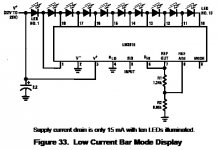Hi!
¿Is it possible to use the Lm3915 with dual rails?. I plan to use +/-16v, and a drop resistor in the +v rail.
Why i want to do this?. Because i want to use the lm3915 with leds in series, instead of typical paralell arrangement, in order to reduce current draw.
Leds will be powered between +/- 16v.
I just want to know if it is feasible before messing with the circuit...🙂
Thank you for your advise!
Jay x
¿Is it possible to use the Lm3915 with dual rails?. I plan to use +/-16v, and a drop resistor in the +v rail.
Why i want to do this?. Because i want to use the lm3915 with leds in series, instead of typical paralell arrangement, in order to reduce current draw.
Leds will be powered between +/- 16v.
I just want to know if it is feasible before messing with the circuit...🙂
Thank you for your advise!
Jay x
No, you can't do this, it takes a single supply of 3 to 25V above signal ground. Each output LED is driven constant current, they have to be in parallel.
Where did you find LM3915's. I bought some on eBay and they were all defective. I tried them one by one in an old circuit I had with 10 leds. I wanted to make one with 20 leads to display a 60db range.
Figure 33 from the LM3915 datasheet ...
Yes, but it shows at-least 22V supply. Figure green LEDs as 2V, stack ten of them, allow a bit extra, that's about right.
I assume Jay does not have 22V.
(However a solid 16V regulated ought to start about there... and the LM3915 does not need real clean power....)
The problem with bridging it across +/-16V rails is the voltage being measured has to be referenced to the NEGative rail, which is usually awkward.
Unless you work in sunlight, modern LEDs are so very efficient that ten might run fine in parallel on 1 milliAmp.
I think the brightness of the LEDs will vary with this connection - the currents from each sink will accumulate up the chain, assuming good constant-current behaviour.Figure 33 from the LM3915 datasheet shows a bar graph circuit with LEDs in series for low current drain.
Pin 9 is left open so the circuit runs in dot mode. Only one LM3915 output at a time sinks current. Even though the IC runs in dot mode, the series connection of the LEDs yields a bar graph display. This circuit cannot produce a dot display. There should not be a brightness variation.
This circuit is not a drop-in solution for the OP. It just provides ideas on something that may serve as a base for a low current display. The 22V - 26V supply might be derived from a voltage doubler, charge pump, DC-DC converter etc. With 1mA through the LED string, operating current might be as low as 7 mA. More specific details on the application would be needed to determine if the circuit is a good fit.
This circuit is not a drop-in solution for the OP. It just provides ideas on something that may serve as a base for a low current display. The 22V - 26V supply might be derived from a voltage doubler, charge pump, DC-DC converter etc. With 1mA through the LED string, operating current might be as low as 7 mA. More specific details on the application would be needed to determine if the circuit is a good fit.
And when the chip was designed LED forward voltages were about 1.4V as red was the only option.
10 white LEDs in series won't work from 25V supply as they need more like 3.0 to 3.2V each. A lot of modern green LEDs are also 3V note, unlike the older versions. I'd stick to red+orange if using the series arrangement and make sure the voltage is high enough for them.
10 white LEDs in series won't work from 25V supply as they need more like 3.0 to 3.2V each. A lot of modern green LEDs are also 3V note, unlike the older versions. I'd stick to red+orange if using the series arrangement and make sure the voltage is high enough for them.
- Home
- Source & Line
- Analog Line Level
- Using Lm3915 with dual supply
